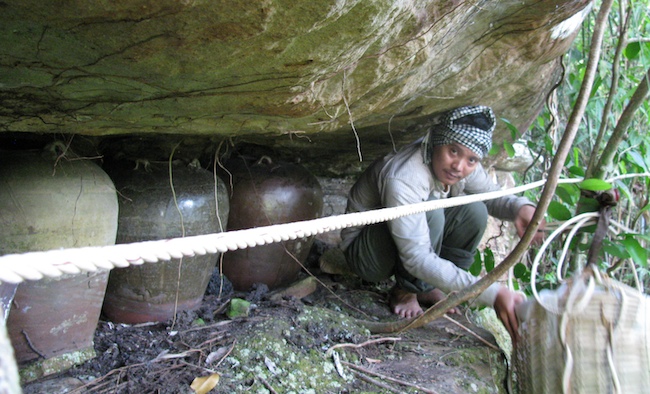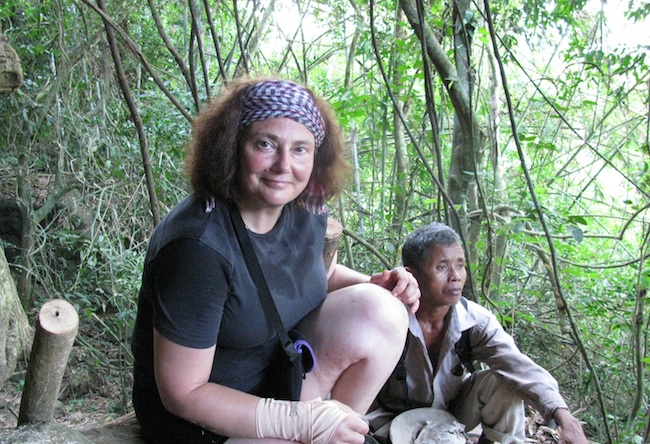Neak ta moves in mysterious ways
3rd Place winner in the Cash for Christmas competition
~~~~~~~~~~~~~~~~~~~~~~~~~~~~~~~~~~~~~~~~~~~~~~~~~~~~~~~~~~~~~~~~~~~~~~~~~~~~~~~~~~~~~~~
We were awakened in the early morning hours by our camp crew banging on cooking pots, yelping “WHOOAH” and whistling. Sticking my head out of the tent, I squinted through the darkness and the smoky vapour trails of the three large campfires that had died out in the night, trying to figure out what fresh hell was happening, when our lead worker Mr Kan appeared through the gloaming to excitedly yell at me, “Damrei!!!”
Oh, right. Elephants.
We were deep in the Cardamom Mountains, on a fieldwork mission to survey one of the enigmatic Jar and Coffin Burial sites that I have been studying here in Cambodia for the past eight years. Our camp for a crew of fourteen had been pitched in a meadow by a lovely rocky stream that attracted scores of blue and yellow butterflies, less than a kilometre from the rock ledges on a hillside where we had worked for the past week on the archaeological site of Phnom Pel, and its 15th century log coffins and exotic ceramic jars filled with human bone.
This fieldwork had been the outcome of years of vying for highly competitive funding, and finally having cash in hand, I had organised our January 2010 trip with military-like precision. Which, of course, was totally mad, as the TIC (This Is Cambodia) factor was bound to scuttle the scheduling and movement of people and equipment from Phnom Penh to a bridge at Andoung Touk, Koh Kong province, then two hours by a wooden boat up the Phipot River to the village of Chi Phat, and then by a caravan of motorcycles and oxcarts into the mountains northeast of the village.
And I should have been wary when, against all odds, the scheduling and movement of people and provisions went like clockwork. While the crew assembled our camp by the stream, I went with a Chi Phat village elder and his assistant up to the rock ledges to perform a ceremony to the neak ta, the forest spirits, offering them coconut milk, rice wine, bananas, incense, perfume. My prayer to the neak ta was simply, “We are here, we are sorry for any disturbance, we will respect these ancestors while we do our work.” I should have added, “By the way, please don’t screw around with me, I actually do come in peace.”
Because the neak ta appear to have a sense of humour, and they were probably bored from just spiriting around for a while, with few people, much less an academic baraing girl, to mess with. The next day as I was crossing the stream by our camp (and I admit, in flip-flops and in contravention of the Health and Safety manual that I had written), and I fell, my right hand slipping between two rocks and producing a resounding “CRACK” that attracted the crews’ attention. I remember lifting my hand from the water and being oddly relieved not to see bones sticking through skin. Assuring everyone that it was probably a sprain, we spread Tiger Balm over the wrist and wrapped it in a bandage. While it did swell mightily over the following eight days, it really did not hurt, and so I was unaware that I had actually snapped and crushed my radius bone until an xray was taken ten days later in Phnom Penh. Sian, the skeletal analyst on my team, looked at me after viewing same x-ray, shook her head and said, “You hard bitch.” It might have been a compliment.
Then of course, was the moth in the ear. While half asleep, I swiped at a fluttering near my face, only to have the fluttering thing enter my ear canal. Immediately awake because the thing was now buzzing in my ear, I thrashed about in my tent whacking the side of my head to try and dislodge the thing, which of course woke Sian in the next tent. With a mixture of concern and barely suppressed amusement, she tried to pick the moth out with tweezers but the light was too dim in the tent.
Taking me outside to one of the campfires we kept burning through the night, she came up with the idea of pouring water into my ear to try and flush the moth out; failing the first time, I insisted that she try smacking me upside the head after pouring in the water to help move the bug along. After a couple of goes in this manner, we finally noticed that one of the crew who had been on guard by the fire had been watching these crazed baraing women doing the water-in-the-ear/smack upside the head thing, in the middle of the night. And he sort of looked afraid.
A day later, as I squatted on a rock ledge at the archaeological site and directed the work, my mind wandered. The work was going well, the team were performing fantastically and in general we were having a really positive experience. Except that I had a swollen wrist and a useless right hand, and the damn moth was still in my ear (it apparently had survived even the drowning and every so often would buzz in an attempt to dislodge itself). I went down from the ledge, grabbed some filled cakes the team had for snacks, and some incense, and went off to give another offering to the neak ta. “Look, really, I’m doing my part here with being respectful and all, and ha ha, good joke with the wrist and the moth, but COME ON... please?” The smoke of the incense lazily swirled up through the light green forest canopy, along with my plea.
The next day I stayed in camp to sieve sediments – a mixture of bat guano and dirt that we had collected from the bottom of the coffins. The moth had finally come out of my ear with the aid of a syringe of water. My wrist, though, was worst than ever, but we only had two days to go before breaking camp. Painfully now, I slowly went through the mixture ... when a small, half circle of heavily corroded metal appeared. And then another. I looked up at my team-mate Ouk Sokha from the Ministry of Culture, who spoke not a word of English, and I started to cry. Sokha immediately thought that the pain of my wrist was the cause of the tears, but the happy dance I did around the worktable confused him. These little metal objects were finger rings, and finding them here at Phnom Pel was an exciting piece of evidence that this site was furnished with the same grave offerings as another site we had studied some 50 kms to the north. And because these little metal fragments were so heavily corroded, it was more than a bit of luck to have found them at all. More than a bit of luck, indeed. Thank you, neak ta.
So when the elephant tried to get into our camp, I was somewhat sanguine about the deal, unless of course, she stomped someone. This fieldwork experience had taught me that you have to roll with the locals, and the locals here are the neak ta, and of course, the elephants. We had pitched the camp between two stands of wild banana, and elephant scat and trashed banana trees on one side of the camp clearly indicated that she needed fresh eats. Fair enough, and a day later we packed up and went home. But not before a torrential rain on our last night in camp made a sodden mess of nearly everything. As I wrung out towels and rolled wet canvas, one of the Khmer team mates said to me, “The rain was a good sign, a blessing.” And I smiled, because after all, our experiences were fodder for stories we would dine out on for years to come, and we had discovered so much including those wonderful rings, and we had worked together as a joyful team, no matter the circumstances.
We had been blessed, indeed.
~~~~~~~~~~~~~~~~~~~~~~~~~~~~~~~~~~~~~~~~~~~~~~~~~~~~~~~~~~~~~~~~~~~~~~~~~~~~~~~~~~~~~~~
Dr Nancy Beavan is a Senior Research Fellow at Otago University, New Zealand. She is living in Cambodia to study the archaeological history of sites in the Cardamom Mountains.
- 29012 reads
- Printer-friendly version


